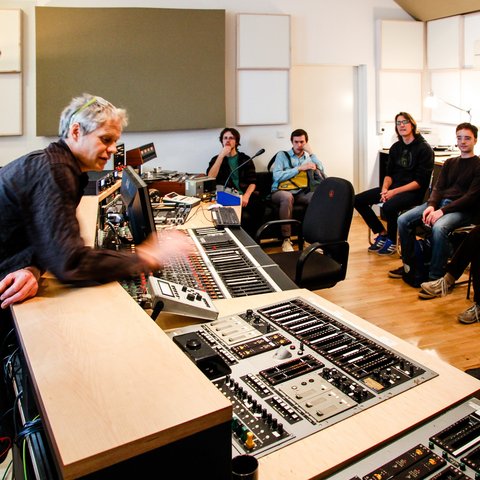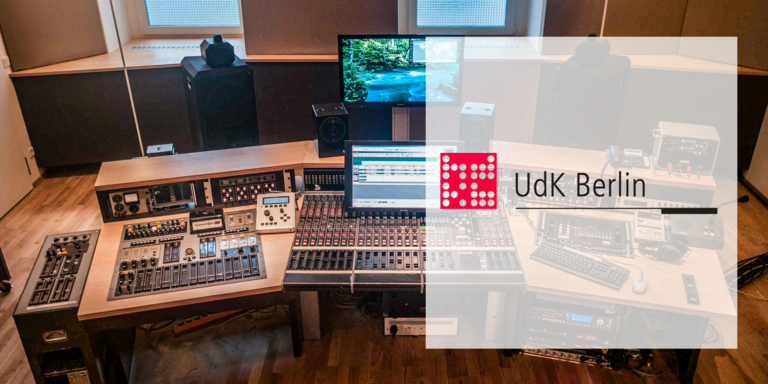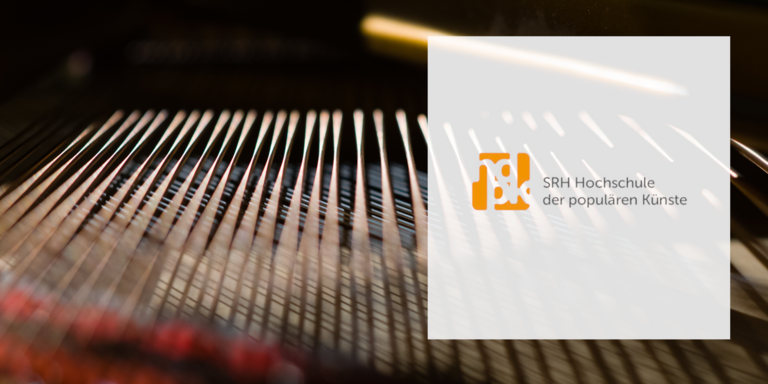We pass on our knowledge
Emil Berliner Studios organize seminars in which we share our own know-how in sound with you. We address subjects such as miking, mixing, editing, vinyl mastering and immersive audio mixing. Target audiences are educational institutes and event organisers from various sectors. Seminars can also be offered as part of a conference and Emil Berliner Studios make an excellent study trip destination.
Past seminars
The Creation Of An Art Product
by Rainer Maillard and Thomas Görne
Naturalness
In the context of man-made music, where highly artificial tools such as musical instruments, concert halls and stereo systems come into play, we like to speak of natural sound - and are thus actually subject to a linguistic misunderstanding.
Duden defines »natural« as »belonging to nature«. According to this, no Stradivarius, Steinway grand piano, philharmonic hall, and certainly no microphone is "natural" and cannot sound natural per se. All these things were created by humans, were developed, built, improved and used according to human ideas and ideals.
Nevertheless, the term »naturalness« is often used in the production and reproduction of music; most people think that the music should sound exactly the same on the record as in the concert hall. But this approach - if it could ever be realized - would lead to entirely unsatisfactory results.
A good recording is not about naturalness, but about fulfilling expectations. The ultimate goal should be to provide the listener of the record with the best possible listening experience.
Expectation, ideal and irritation
Sound surrounds us like air. Since our childhood we have experienced how rooms react acoustically. We can hear rooms: We hear the distance between walls, we hear the height of the ceiling, we hear the surface texture of walls. The bathroom sounds narrow, the concert hall sounds wide (even if both have the same reverberation time). Steps in the staircase sound different than in the living room, the grand piano sounds different in the last row of a large hall than in the first row of a small hall. If our listening expectations are not met, we are irritated.
But what should a piano sound like that sounds like from the loudspeakers in the living room at home? As if it were standing in this living room? Or as if it were standing in the Wiener Musikverein, even though you are sitting in a living room? And if it is the Musikverein, should it sound distant like in the last row or close like in the first row? Real ambience (living room) and imaginary ambience (concert hall) are blended together. Out of this special situation, we have developed a certain sound aesthetic; unlike in a concert, the direct sound of an instrument is the main focus here.
The adequate ambience
From a music production perspective, it is not important whether a room is »goodt« - it should be adequate. For example, an organ piece by Widor only sounds adequate in the acoustics of a large church; an orchestral work by Mahler requires a larger concert hall (with later reflections and longer reverberation time) than a Mozart symphony. A jazz combo sounds muddy and unprecise in a chamber music hall, a string quartet in a jazz club sounds harsh and distorted. There is no such thing as an all-purpose recording space; different instrumentations and different repertoire require different spaces.
If the room does not meet the requirements, the recording engineer can try to compensate for that within certain limits, so that the listener does not notice the difference compared to the recording in a more suitable room.
Minimizing the room acoustics
The recording room is »folded« in a way by the recording and playback: While reflections in real space reach us from all directions, the three-dimensional space appears reduced to two dimensions in stereophonic playback, to one level between and behind the loudspeakers. Other methods like 5.1 surround are slightly better here, but still far from the original three-dimensionality. Even with wave field synthesis, the holophonic image of space appears two-dimensional. And reproduction techniques with loudspeakers arranged vertically one above the other can also only represent the room where the loudspeakers are. The recorded room that is reproduced via loudspeakers is alienated by the reduction in the "bottleneck" of the recording chain.
Reduction of the senses
Until the end of the 19th century, music could only be experienced live, from musician to listener. Since Thomas Alva Edison and Emil Berliner, music has become available everywhere at any time. The reproduced musical experience is reduced to audio only. However, a musical concert experience is not a purely acoustic one, it appeals to all senses. And the eye is most dominant: we hear what we see. The soloist, dressed in the most beautiful concert attire, stands in the middle of the stage in front of the orchestra, illuminated by the spotlight. The listener follows the facial expressions, the bow stroke, with great suspense. Even if the brass should drown out the soloist for a short time, the other senses help create a perfect musical experience. This is what we call directed attention.
In music production, the hand on the mixing console compensates for the lack of sensory impressions, it directs attention like the spotlight in a concert: Thus, on the recording the soloist is louder in relation to the orchestra than in the concert hall.
Designed sound
One cannot not create (after Paul Watzlawick's axiom of communication psychology »One cannot not communicate«). Even the non-design is design because it has an effect on the listener: this is also how an amateur's recordings are designed, even if not always to their advantage. And so-called »audiophile« recording techniques (for example, when the ensemble is recorded with a single stereo microphone, transmitted via special cables and amplifiers) are no better or worse than "more conventional" methods, they are just different. The result depends less on the technology used than on the imagination and creative powers of the recording engineer. And just as one can identify a regional cuisine or a particular cook, the characteristic sound of a Tonmeister is also audible. A recording by Günter Hermanns, Herbert von Karajan's longtime recording engineer, always sounds like Günter Hermanns, regardless of whether the recording was made in Berlin's Jesus-Christus-Kirche, the Philharmonic or the Vienna Musikverein, regardless of whether it was recorded in analog two-track or digital multi-track technology.
Adequate technology
No musical instrument, no radiation behaviour of an instrument, no room acoustics, no recording medium is perfect. This is neither necessary nor desirable; it is solely a matter of the result that arises from the interaction of a whole chain of individual parts. If a hall sounds »dull«, a »bright« sounding microphone helps. If a violin sounds »harsh«, a »round« sounding microphone can help, and a different microphone position helps to pick up more or less overtones from the instrument. A successful recording is like a successful menu: Most important is the tasteful combination of the individual parts. The soup will not taste good without salt, but still salt alone is not a quality feature - the soup could also be spoiled.
Even though the basic requirement is that the tools used are of high quality, other parameters are much more crucial for the sound: for example, the microphone position has a much greater influence on the sound than the type of microphone. Microphones that sound different at the same position can sound very similar at different positions. The individual technical aspects of the recording chain are often brought into focus, and these discussions are often dogmatic (»Only microphones AB on preamp XY sound free and open«). But such dogmatism leads to a dead end, because every dogmatic restriction limits the creative freedom. A cook may like spaghetti best, but some dishes simply taste better with linguine...
Illusion
A successful recording is neither a reflection of reality, nor is it a technically reproduced concert experience. The successful recording is an illusion created with technical means, it draws listeners into the music, it takes them along, seduces them. In movies, sounds are subtly used to catch the viewers' attention and direct it to details of the action. Similarly, a good music recording catches the listeners, it touches them.
Perfection
Music is art in time. It passes in the moment of creation. A picture, a sculpture lasts for centuries; music exists only at the time and place it is played. Recording tears the music out of the flow of time and out of its spatial and sensual context; it enables us to hear the same interpretation of the same piece over and over again. But the sofa in the living room is not the concert hall, the recorded piece is not the piece played in the concert, even if the recording was made in that concert.
Sound editing helps to adapt a music production to the requirements of the time- and context-less record. On the one hand, editing allows for the removal of imperfections. On the other hand, combining different takes from the recording is one of the most important creative tools for post-production. This creative process can lead to amazing musical results. Nevertheless, the sound editing has a negative reputation, because the music has been »manipulated«, because the perfection achieved a record as a piece of art is »not natural«.
While, for example, the need for editing a film is understandable for the viewer, the editing of a music production remains inaudible; as listeners we have no chance of tracing the process of montage. As a consequence, there is an Oscar for »Best film editing«, but there is no Grammy for best music editing.











